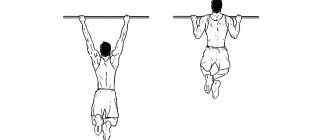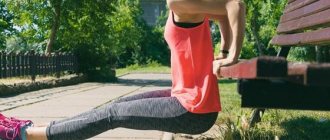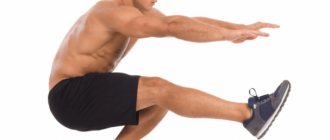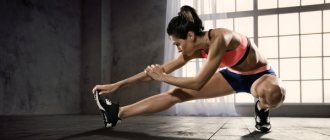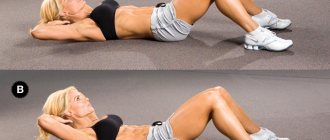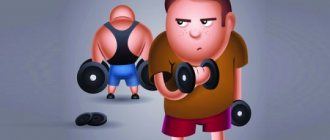The essence of the program for beginners
The tasks of beginners who first cross the threshold of the gym are similar. Guys want to improve, become better, have a healthy and attractive appearance.
In more detail, the essence of any training program for beginners is:
- development of general training ability - the body's endurance during training, the ability to quickly recover after exercise;
- improving muscle coordination, training exercise techniques;
- increasing efficiency - increasing the volume of the program;
- increasing strength indicators.
As the novice athlete achieves these goals, he approaches others - gaining muscle mass, burning fat, improving overall health.
Exercises for the pectoral muscles
Push ups
You can do push-ups with equal efficiency both in the gym and at home. So if for some reason you are temporarily unable to go to the gym, then push-ups will compensate you for a full chest workout.
Lie down on a gymnastics mat, place your hands with a wide grip and bend them at the elbows. The body weight is supported on the feet and bent arms, the back, head and legs form one straight line. Rise up, straightening your arms while keeping your back straight, then lower to the starting position.
Girls can choose an easier type of push-ups - knee push-ups.
Wide grip bench press
Exercise for the full and harmonious development of the latissimus dorsi, chest, shoulders and biceps. Lie down on a horizontal bench with your feet firmly pressed to the floor.
Using a wide grip, grab the barbell and slowly remove it from the support with your arms outstretched. Then slowly lower the bar parallel to your chest, while your elbows should move along a clearly defined path. As you exhale, press the weight back up and hold it for a few seconds at the highest point.
The advantage of this exercise is that you can vary the effect on the upper or lower chest. For more work of the upper pectoral muscle, use a bench with a slight incline, while a regular bench will engage the entire chest.
How to write a program correctly
The most effective training program will be one based on the individual characteristics of the beginner.
When selecting exercises for a beginning athlete, it is necessary to take into account 3 main factors:
- Age. This factor determines the list of acceptable exercises. For example, it is better for a 16-year-old teenager to refrain from performing heavy deadlifts.
- Health status. A person suffering from varicose veins should reduce the load on their legs.
- Regime and lifestyle. When creating a program for an office manager and a loader at a factory, different approaches are needed.
Training schedule
The training program for a beginning athlete looks something like this:
| Day of the week | Week #1 | Week #2 |
| Monday | A | B |
| Tuesday | rest | rest |
| Wednesday | B | A |
| Thursday | rest | rest |
| Friday | A | B |
| Weekend | rest | rest |
Training takes place on Monday, Wednesday and Friday - three times a week. The two types of training alternate every other time. This schedule of training in the gym is the most optimal: the muscles are well pumped during the workout and have time to recover after the load.
Gym workouts for beginners
If you haven't already, read my Beginner Workouts and Routine article to make sure you're truly a beginner and learn what the basic principles and goals of a workout program are right for you.
Let's get into the details of what I call the Beginner Strength Training Program.
Training schedule
The first thing you need to know about this program is what split training is and the weekly schedule it follows.
If you've read any of my articles on strength training frequency or split training schedules, you probably know what split we're going to use.
Of course, I'm talking about the 3-day split for all muscle groups, which is by far the most proven, and is often recommended as a training schedule for beginners, regardless of their goals.
What muscles can you train in one workout?
Here is the most common and logical option:
| Monday | Back, biceps |
| Wednesday | Chest, triceps |
| Friday | Legs, shoulders |
The main muscle groups are distributed by day. To each large group, small muscle groups are added that take part in the main training (excluding training of the shoulders and legs). It's simple: let's take chest training, which includes exercises based on pushing (squeezing) weight away from the chest. This function is performed by the triceps, which should be trained together with the pectoral muscles.
We adhere to the same principle when planning a back and biceps workout. The shoulders are not involved in pumping the legs, but Friday is the most convenient day to ensure a high-quality load on the deltoids.
The above program should not be taken as a postulate and there is an alternative plan for training muscle groups. As follows:
| Monday | Chest, biceps |
| Wednesday | Back, triceps |
| Friday | Legs, shoulders |
This option is less popular. Its supporters consider it pointless to train a secondary muscle after it has already been involved in working out the main muscle groups. Therefore, biceps and triceps have moved in the table.
The third and no less effective training option for beginners: working out all the main muscle groups in one workout. This plan is the most energy-intensive and is not suitable for everyone.
Training cycle in 3 stages
The entire training cycle according to the program for beginners can be divided into 3 stages.
Stage 1 . The key element is warm-up and aerobic exercise (running, walking, swimming, cycling, etc.). The main task at this stage is to accustom the body to systematic loads, increase overall endurance, strengthen joints and ligaments, increase their mobility and nutrition.
Usually, on average, this stage takes from 2 to 4 weeks. The less experience you have in playing sports and the older you are, the longer this stage will be. If the training is not too intense, you can even do it every day.
Stage 2. Here you can switch to strength training, starting, as we have already said, with practicing technique and light weights, and gradually increasing the load. It is better to exercise 2 or 3 times a week, for example, on Monday and Friday, or Monday - Wednesday - Friday. It is best to do exercises for the whole body each time, but you can also distribute them according to a split scheme (for example, Monday - back and biceps, Wednesday - legs, Friday - chest and shoulders), but giving preference to simple universal exercises (deadlift, pull-ups, dips, squats, etc.), which involve large muscle groups.
You can do this for one to two months or more. As soon as you feel that you are ready to move on, move on to the third stage.
Stage 3 . Here, almost everything that we said about the second stage is preserved, but specialized exercises for individual muscle groups are added. This stage can continue as long as you see progress. In general, this can take from 6 to 9 months, and even more - it all depends on individual characteristics.
Pay attention to some features. For example, many have noticed that those muscles that are worked first during training grow more actively. Therefore, change the sequence of exercises. One more point is related to the first. Intense workouts should not be long - if you do not relax in the gym, chatting with friends, but work seriously, then a short workout will be most effective - from 40 minutes to 1 hour. To continue intense work, the body will not have enough energy and will begin to actively break down muscle proteins. This is where the common reason for the lack of progress lies - a person trains and trains for one and a half to two hours, but there is no progress. Because during the first hour the body uses up its energy reserves, and then burns the hard-earned muscles. Intense training should not be too long. Low-intensity training used for weight loss is a different matter - they can be longer than strength training.
Where to start training
The beginning of any workout involves a warm-up.
A cardio machine is perfect for these purposes. Beginners should prefer an exercise bike. Cardio warm-up usually takes 5-10 minutes.
Then move on to swings, body turns, and pull-ups to the sides. Everyone remembers this warm-up from their school days: we start with the neck, then the shoulder joint, elbow, and wrist.
It is especially worth paying attention to the lower back - this area of the body bears the main load during the training process. Bend to the sides, bend back, stretch to the side, do crunches, rotate your torso. We finish the warm-up - rotate our hips, work our knees and feet.
Training program for beginners
The above programs can serve as an excellent guide for a novice athlete. However, before starting classes, it is necessary to adjust the material based on individual characteristics (age, health, lifestyle, etc.).
Split training program for beginners
A three-day split for a beginner might look like this:
| Monday (back muscles, biceps) | |
| Warm-up | 5-10 minutes |
| Deadlift | 2 sets of 8 times |
| Bent-over barbell row | 3 sets to the maximum |
| Biceps curl (with barbell) | 2 sets of 12 times |
| Abs workout | 3 sets to the maximum |
| Stretching | 5 minutes |
| Wednesday (pectoral muscles, triceps) | |
| Warm-up | 5-10 minutes |
| Bench press with wide arms | 5 sets of 5 times |
| Bench press with narrow arm position | 2 sets of 12 times |
| French press | 3 sets of 12 times |
| Abs workout | 3 failure sets |
| Friday (legs and shoulders) | |
| Squats | 3 sets of 6 times |
| Leg press in the simulator | 2 sets of 18 reps |
| Seated calf raise | 3 sets of 15 times |
| Dumbbell raises | 2 sets of 12 times |
| Army press | 3 sets of 8 times |
| Stretching | 5 minutes |
After Friday, the body needs rest for 2 days. This type of training can be continued for several months, over time becoming familiar with the new principles of training.
Circuit training with machines for beginners
Circuit training in the gym is the best option for a beginner. Among the obvious advantages of such activities:
- the ability to master exercises from the point of view of the technicality of their implementation;
- gradual adjustment of mental-muscular coordination;
- high-quality preparation of muscles for more significant loads.
For girls, I recommend reading the article “Circuit training for girls.”
With this type of training, the fitness trainer usually adheres to the “big to small” principle. However, if you believe in practice, not every beginner has enough energy and physical endurance to work out other muscle groups after heavy exercises on the lower part.
The most favorable option for circuit training for a beginning athlete is as follows:
- After a five-minute warm-up, we completely perform the first exercise on the back muscles (in 2-3 sets of 12-15 repetitions). Having completed one set, we rest. Then we proceed to chest exercises (2-3 sets of 12-15 repetitions). Then we move on to the shoulders and continue according to the same principle. This way you can train for the first two weeks.
- With the beginning of the third week, we add one more exercise for the main muscle groups (back, chest). Then we continue to adhere to the same principle: after performing 2 exercises on the back muscles (in 2-3 sets), we begin working on the chest. We don’t rush with the legs: we leave one previous exercise (squat or bench press). The same applies to small muscles - we perform one exercise each for biceps, triceps and shoulders.
Cardio workout for beginners
For a beginner athlete, during cardio training, it is important to perform a block of exercises that would allow evenly loading all areas of the body. This goal is perfectly achieved by doing aerobics and dancing. In the process of performing a specific element, you should maintain tension in those muscle groups that are currently tense - this will increase the effectiveness of the exercises.
A cardio training complex for a beginner may include the following exercises:
- Run in place. We grab our hips with our heels.
- Jumping (legs spread/closed). You can also use your hands, simulating the rotation of a jump rope.
- "Jumping jack" - wide jumps. At the same time we raise our hands.
- Running with high hips.
- "Mill".
- Leg-scissor jumps. We jump up and change legs in a forward and backward direction. We press our hands to the body.
- "Pendulum". The body is vertical to the floor, hands are pressed to the shoulders, one of the legs is supporting, the other is moved to the side. Alternately change the emphasis on the leg.
- Feet together, jump to the sides.
- Let's box.
- We squat deeply, our back is straight, we throw our arms out in front of us.
A beginner should give preference to such cardio training during the first two months. After this, you can connect running in the fresh air, running on sports simulators, cycling, exercise bike, jumping rope, etc.
How to use the complex for weight gain and weight loss?
This set of exercises for beginners at home is designed for the first 2-3 months of training from scratch. Men and women can follow it, the main difference will be the working weights; for girls you need to take less.
To gain muscle mass with this training regimen, you need to use working weights with which you can do no more than 10 repetitions in one approach.
To lose weight, you need to perform exercises as intensely as possible in the style of endurance training, more than 15 repetitions per approach. A superset scheme is also good, in which you perform exercises one after another. For example, we did push-ups from the floor 10 times and immediately went to press dumbbells while standing, also 10 repetitions. We rested for a minute and a half and repeated the superset again. Do this up to 4-5 approaches, then take the second pair. The training should last no more than 1 hour, it is better to do it in 50 minutes. You can train like this 3-4 times a week, and if you have the desire and strength, you can do it more often.
If you have any questions, ask them in the comments.
How to Make a Workout Program Work
To achieve this goal, a beginner should adhere to the following rules during training:
- We focus on the form of execution. First, we determine our working weight, which will allow us to perform the exercise in the proper form (technically). After confidently completing the entire volume of exercises, you can move on to a gradual progression of working weights.
- We perform all the sets and progress in loads. We are talking about volume-strength progress, which involves a consistent increase in load while maintaining the technique and numerical parameter of the exercise.
- We follow the plan and don’t experiment.
By following these three principles in the gym, a beginner can rightly count on good athletic results.
Recommendations for beginners
The training regime for beginners in the gym or at home depends entirely on the goals. If we are talking about muscle mass , then men and women should concentrate on performing 8-12 repetitions (8-10 in basic and heavy movements, 10-12 in light and isolating ones, for example, biceps curls). The main indicators should be muscle failure and general fatigue.
Beginning athletes should treat training at home with the same seriousness as going to the gym. This will ensure rapid progression and erase the main differences between conducting classes in the gym and at home.
- For beginning male , it is optimal to focus on increasing strength. This will also ensure an increase in muscle volume.
- training for beginner fitness girls into the plane of high-repetition and intense work. The exception is when increasing muscle mass becomes a priority. In this case, any “male” training program will do.
And also read how a girl can gain muscle mass →
Basic recommendations:
- Approaches, rest and other conditions are selected for specific purposes. 6-8 – strength work, 8-12 – emphasis on mass, 12-20 – high-repetition training with an emphasis on strength endurance.
- Fitness for beginners is aimed at developing the body. Changing the amount of fat mass is carried out exclusively by adjusting the diet.
- Watch your breathing during exercise. Inhalation is always done at the beginning of the movement, exhalation - in the most difficult phase of the repetition. This helps minimize straining and pressure in the vessels.
- Always make sure that your back is straight (the exception is exercises like crunches, where rounding the back is a necessary condition).
- To start training from scratch at home, just get a pair of dumbbells. This will allow you to perform up to 90% of all exercises.
Do you need a coach?
If it were not for the issue of price, most beginners would end up training in a gym with a personal trainer. There are several reasons for this and they are quite objective:
- training with a trainer gives beginners confidence. After all, many beginning athletes are shy, suffer from complexes, and experience a feeling of fear;
- the coach helps the beginner avoid unpleasant situations. Injury in the gym can be caused by an incorrect assessment of one’s own strength, violation of the technique of performing an exercise, and inability to use exercise equipment and equipment;
- The trainer is able to create an individual training program for the client. At the same time, the professional takes into account the beginner’s current level of physical fitness, his goals, wishes, and body characteristics;
- the coach, observing the client from the side, can point out to the novice athlete a mistake, teach the correct technique or make the necessary amendments to the program;
- according to statistics, with a coach, a beginner achieves good, sometimes excellent results much faster;
- a coach motivates a beginning athlete, sets him up for training, supports him, and prepares him for future success.
However, to answer the question “Do I need a coach?” Each aspiring athlete must independently weigh the pros and cons, take into account his recent relationship with the sport and evaluate his own internal state.
The following training programs for beginner athletes can serve as decent models when creating an individual program. The choice of exercises, number of repetitions, sets and pace of exercise are selected taking into account the individual characteristics of the body.
Regardless of the type of training and training regimen, it is important not to be guided by three basic principles aimed at mastering technique, progressing in working weights, following a plan and not experimenting. Such an approach will not only prevent the development of unpleasant situations, but also ensure the achievement of the set goal, no matter how unattainable it may seem.
Progressive workouts
Why with progression? Because if the muscles can cope with the current load, then there is no point in growing! The body is a very “cunning bug” and it does what is beneficial to it! Muscles spend a lot of energy, so the body tries to minimize muscle growth. He always leaves you exactly as much muscle as you need to carry out your life activities!
It doesn’t matter to him whether you’re crawling up a tree for a banana or destroying your muscles in the gym, he’ll increase his muscles as needed! In short, the only way to build muscle is to get stronger!
How to do it? To do this, you just need to keep a training diary! I gained almost 20 kg of weight in a year only because I wrote down all the results in a training diary. I wrote about it and how to increase the load in more detail in this article .
There are many options on how to create a training program for a beginner, but I want to say one thing: there is NO universal training! Each organism is individual and how adaptation to stress and muscle tissue will proceed depends on many factors, such as gender, age, fitness, genetics.
Now I will give a scheme according to which you will need to practice in the first 3-4 months of your training. What is characteristic of this period?
- Poor muscle-brain connection (a beginner does not understand and does not know how muscles contract), and also, they are not able to abstract themselves (forget that someone is looking at them).
- Any physical activity is stress for an unprepared body, so there is no point in overloading the system with excessive weights
- Muscle fibers adapt to new loads, so fairly rapid increases in strength and volume are observed.
- There is no point in dividing workouts into splits (by body parts), because... this is necessary for a targeted, increased load on the muscles being worked.
These were the main points. I'll quickly go through all the points before giving you a program in which you will need to begin the path to climbing to the top, where respect, beautiful girls and success await you.
Poor muscle-brain connection. Most beginners come into the gym and just mindlessly lift and press weights without thinking about how the muscle they are working works. This is fine. This is the mistake of almost 100% of new bodybuilders. You need to read about how to learn how to contract muscles here.
I think it’s understandable about stress from any physical activity. Your goals in the first months are to establish the correct technique for performing exercises, get your body used to weights, and be able to focus on the muscle being worked.
Next point. In the first months of training, quite large increases in muscle volume and strength are observed, do not rush to rejoice, this is only the body’s response to an external load after a “long sleep”.
I advise you to measure all your volumes with a centimeter and write down all the data on paper. In a month or two, measure yourself again and you will be pleasantly surprised. Just don’t be a fan of it, don’t measure every other day and expect crazy gains.
Further. There is no point in splitting in the beginning. A beginner’s muscles are not adapted to such loads and such training will not give the expected result, as for example after 1.5-2 years of training. Just forget about it for now. Everything will happen, but everything will happen in due time.
Next point. Most beginners cannot abstract themselves. They think that everyone in the room, and even people passing by, is looking at them to laugh at their still modest results. My dear friends! Understand that everyone in the gym is focused only on themselves and no one cares how you work out. Everyone was there at first, just like you. They came to the hall with frightened eyes and were afraid of doing something weird. Relax! The race you are running is only with yourself.
You should be better than only one person today, that was you yesterday.
What types of exercises are there?
Exercises are divided into basic and isolating. Read more in this article.
Compound exercises involve multiple joints and muscle groups during their execution. Such exercises include, for example: bench press/dumbbells, squats with a barbell/dumbbells, barbell rows, etc. The principle, I think, is clear.
Isolation exercises involve only one muscle group and one joint. For example: leg extension/bending in a machine. Such exercises are good for pumping blood into the muscles or for pre-tiring the muscles, but not for great muscle growth.
Therefore, in the training program for a beginner, I included only basic exercises! No isolation for a year and a half of training!
Now it's time to get down to the fun part. How you should train in the first 3-4 months of your training.

